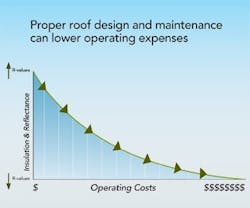Roof Insulation and Reflectivity Cut Costs
There are two ways in which roof designs can directly impact operating costs: the insulating value of the roof system and the reflectivity of the roof surface. Minimizing heat loss from the interior in winter months and minimizing heat transfer in the summer months should reduce HVAC requirements and, thus, lower operating costs.
Roof Insulation
In winter, the heat moves from heated indoor spaces to the outdoors (wherever there’s a temperature differential). During the summer, heat moves from outdoors to the interior of buildings if there’s a temperature differential. Well-insulated roof systems decrease the heating or cooling needs by providing effective resistance to the flow of heat.
The effectiveness of an insulation material is measured by the material’s R-value. The higher an R-value, the better it is at resisting heat transfer. Roof insulation products have differing R-values. In addition to R-value, roof insulation must be chosen based on compatibility with the roof membrane, roof deck, adhesives, etc. Many building codes in the United States typically require an R-value of 20. Specific building codes should be referenced before selecting insulation. Many commercial roof insulations have an R-value of about 5 per inch thickness, which would typically require about 4 inches of insulation to reach R-20.
Reflectance
Radiation from the sun can also transfer heat to a building. The ability of a roof membrane covering to limit heat gain from the sun’s radiation is a result of the roof’s solar reflectance and thermal emittance. A roof membrane with higher solar reflectivity will reflect a large portion of the sun’s radiation back away from the building and into the atmosphere. Thermal emittance is the relative ability of a roof to radiate absorbed heat out before it enters the building.
An index factor has been developed that combines solar reflectance and thermal emittance values. The combined index is the solar reflective index (SRI). The USGBC requires an SRI of 78 or higher for a roof membrane covering as part of its certification rating systems for new construction and existing buildings. Additional information on solar reflectance and thermal emittance is available from the Cool Roof Rating Council at www.coolroofs.org.
Some consideration should be given to the location of a building with respect to solar reflectance. The SRI value of 78 is required by USGBC in part to lower the heat island effect of buildings; however, roof systems with lower SRI values might be beneficial in the northern United States due to the greater potential for heat gain into the building in climates that require more heating than cooling.
Proper Maintenance
By being proactive with inspections and maintenance, minor issues can be corrected before becoming major problems. Proper maintenance can also extend roof service life, which lowers costs over the life of the asset. Roofs should be inspected on a periodic basis (at a minimum, twice a year and after significant storms). During inspections, the roof membrane and flashings should be checked for defects, including holes, splits, or other openings. In addition to the potential damage caused by roof leaks, if the roof insulation gets wet, it becomes less efficient in resisting heat transfer (its effective R-value decreases).
- Primary drains and overflow drainage provisions should be confirmed to be clear and operating properly.
- Any debris on the roof should be removed to lessen potential for drain blockage and membrane drainage.
- If the roof has a reflective coating, coating condition should be checked and coating reapplied as necessary. Roof reflective coatings can protect the membrane against UV degradation; lower the surface temperature of the membrane, which can help extend service life; and have a positive influence on reflectivity.
- Any repairs required for warranted roofs should be performed in accordance with warranty terms.
These are just a few of the measures that can be taken to lower operating costs.
Daniel L. Watkins is an associate at Fairfax, VA-based Facility Engineering Associates (www.feapc.com).
